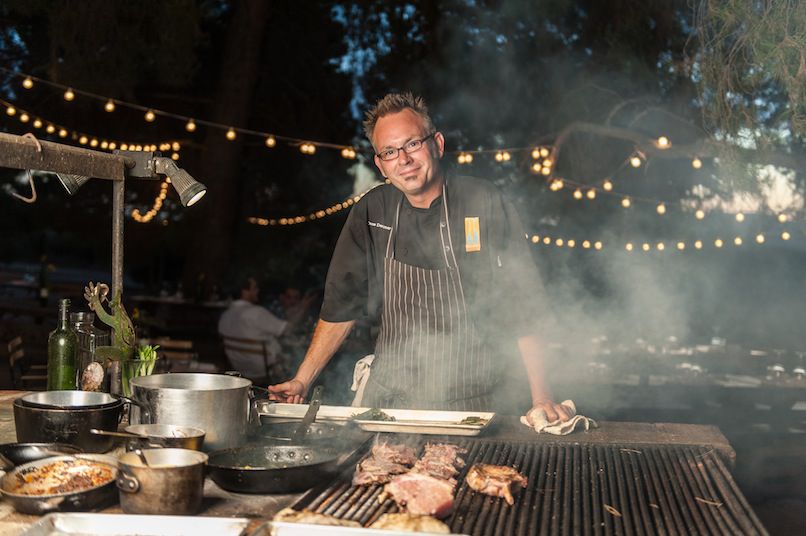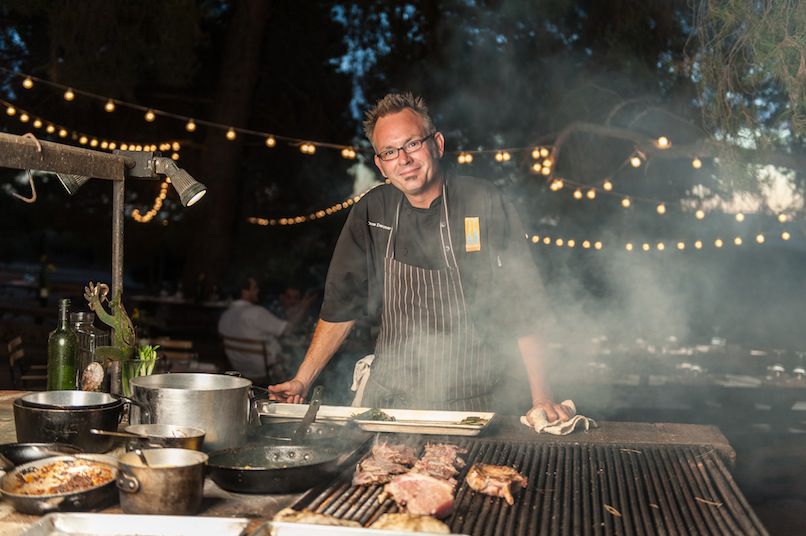Growth is never without pain. And it rarely happens the way people would prefer. Just ask any teenager whose arms currently scrape the ground when he walks. As discussed in our cover story on Baja, growth and development of Valle de Guadalupe—Mexico’s premier wine region, an hour and a half south of the border—is a big issue. Valle icons like chef Jair Tellez and winemaker Hugo D’Acosta talk about the “right kind of growth.” By that, it seems they mean businesses and housing developments that learn the Valle’s character and develop around it, rather than plopping a McDonalds down along the Ruta del Vino.
“I don’t want restaurants with wine-colored walls,” says Natalia Badán, who took over the Mogor-Badán winery, farm and market after the deaths of her brother and his son.
Of course, worrying about the “right kind of growth” is a luxury afforded by the Valle’s financially stable residents. Non-wealthy locals are not as concerned with whether or not new businesses do soul-inventory before setting up shop. They simply need money for their families.
Like any tourist area, small resentments stem from external ideas. A chain business like McDonalds would mar the Valle landscape by using Mexican land to express uniquely American values. With every external voice that goes into the Valle—whether American, Mexican, Chinese or otherwise—the distinct Baja voice gets harder to hear.
Also tough on the locals are unenlightened tourists who expect servitude for their vacation dollars. To a lesser degree, San Diegans can relate to that quiet, inner resentment when wealthy Arizonans come to summer. We moan about “Zonies,” but our local economy also needs their money.
As you wander through The Valle, you can see small examples of the “right” and “wrong” kind of growth. One local points out a billboard for L.A. Cetto as the “wrong” kind. It shows a very well-dressed woman whispering what appears to be a tantalizing offer into a well-dressed man’s ear. The message is fairly clear: Affluent people do luxury romancing at our establishment.
I suppose what’s wrong with this is its anywhere-ness. That woman in bright lipstick and jewels and expensive dress whispering into the dapper man’s ear… could be in Vegas, San Diego, or New York. It’s a very non-distinct, well-worn template of luxury that purports to represent “the Valle de Guadalupe experience” on a massive billboard lording over the main road. It’s that sort of faceless expression/branding that could really undermine the Valle’s distinct, grapes-on-the-moon appeal.
For our story, we drove through the Valle in old cars made of old metal. The “restaurant row” of sorts that’s home to two iconic restaurants—Laja and Finca Altozano—is a dirt road. It shook our old car to its old bones. Some gravel might be nice, and maybe some better signage. But, then what? Where do “improvements” begin to dilute the rustic magic of the Valle? The feeling that you’ve gotten lost and discovered a wine oasis? How do you make improvements that won’t turn the Valle into Temecula or Napa South—a cookie-cutter place with lawn parties and Kenny G concerts that has a lot of money but little Baja soul?
One of the most extreme versions of the “right” kind of growth I found at Deckman’s en El Mogor, the “restaurant” on Mogor Badán. Deckman’s isn’t a restaurant as much as it is an elaborate picnic orchestrated by Michelin-starred chef, Drew Deckman. The “restaurant” consists of wooden tables under some pine trees. Bulb lights are strung through the branches. The ceiling is the sky, and fallen pine needles the carpet. Deckman’s kitchen is a few needles over to the side, made completely of recycled things. He found two old doors from a science class at a San Diego university—which he now uses as kitchen workstations. His massive cutting board is made of floorboards from an old gymnasium. Deckman cooks entirely with firewood (no gas) in traditional Baja style.
I thought it interesting and wholly unsurprising that the area’s main non-Mexican chef had taken every precaution not to be too flashy or disruptive. Though he’s been a resident of Mexico for nine years, Deckman is very cautious not to be mistaken for a disruptive interloper.
Deckman’s food is phenomenal, some of the best I’ve tasted on either side of the border. No surprise coming from a man who trained under legendary French chefs Paul Bocuse and Jacques Maximin. Deckman opened his first Mexican restaurant, Deckman’s San Jose, in Los Cabos in 2010. A year later, he came to The Valle.
Why did you come to The Valle?
I started working here as a culinary consultant for Hugo D’Acosta. It’s tough for a gringo to walk into The Valle and say, ‘Hey! I’m here!’ But when one of the innovators introduces you and says, ‘Hey, this is our chef,’ the doors open a little longer, or softer.
And why did you decide to open your own place?
I’m not a new-agey person, but when I came over the ridge and saw The Valle, I knew I’d been here before. So I talked to Natalia and she said, ‘Why don’t you put something beneath my pine trees?’ The plan was to have a two-month sabbatical. This would be our lab. It was never looked at as a business. Just a sort of creative way to pay our bills while we’re here on vacation. I started with 30 seats. I’ve got 85 now. And now all of a sudden we’re full and need more seats. Last year was our second year and we did almost six months instead of two.
Why did you design the space so minimally?
I was coming into a ranch that had so much tradition. 2012 was the twenty-fifth vintage of Mogor wine. There weren’t a lot of small, artisanal wines when they started. Antonio Badán, rest in peace, was one of the innovators who made it possible. It was so important to me to integrate in a way that when you walked into the restaurant, it felt like it had always been there. There are two tables that are old doors from a chemistry lab at the University of San Diego. The cutting boards are recycled gym floor. It smells like teen spirit.
This year you closed Deckman’s San Jose and will operate your Valle restaurant year-round. Why?
Hugo had said something to me when we were in New York. He said, ‘I think your restaurant is great, but if you want to help The Valle, you need to be in The Valle. You’re here for the summer and then you leave when we need you.’
The plans?
We’re going to build a U-shaped structure made out of hay bales, chicken wire, adobe, and a tin roof. We want something that looks cool, but isn’t permanent. We can break it all apart, save the wire, use the hay for the animals. The challenge is: How do you create different restaurants in the same space? I’m going to reduce it to 30 seats, make it a little fancier, which is my upbringing in the kitchen. But that doesn’t mean we’re going to be expensive or pretentious. Just a little more polished.
Kitchen philosophy?
I’m not a chef. Chefs are the guys who worked for in Europe. Those guys with three Michelin stars for 30 years. My job is to find the best ingredient sand not fuck it up between finding it and you eating it. We use pink peppercorns from the property in the mignonette for the oysters. We only use salt from San Felipe and olives from the ranch. We brew a beer with Agua Mala using honey here on the ranch and grain from Mexicali. There are guys growing hops now here in the Valle.
What’s the restaurant environment like in The Valle right now?
There are so many new restaurants this year. A lot of them spend as much money on advertising as we make in a year. When Javier and I opened, we counted 23 restaurants—not counting taco carts. Now there are over 80. But there’s no other infrastructure. No more hotel rooms. Just a lot more tables and chairs. There’s just not that many people yet to support it all. Eventually the Valle can carry 80 restaurants. But not now. Very few of them have business licenses. There’s no control over who and what goes where. Very few people are paying taxes. We are. It’s all part of being a good neighbor.
So it’s unsustainable?
The wave is big and everybody’s surfing it right now. I think it’s great. The press The Valle is getting is the way it should be. Everyone shows up with big eyes and then walks away thinking, ‘Man, maybe I shouldn’t have sold my house in San Diego.’ We need more homes. Restaurants can’t survive on transient traffic. We can’t go 12 months a year just having a good Saturday every week. There’s just not enough people living here.
Lettie Teague recently wrote an article in the Wall Street Journal that was critical of some Valle de Guadalupe wines. What was the local reaction?
That article was very controversial. She said some stuff that was not in any way, shape or form off the mark. But people here are not accustomed to anything critical. Most of the articles written about The Valle feel like paid advertising. I don’t know why there’s that sensationalism with The Valle. It’s a really special place.
What’s your take on the local wines?
Our list is exclusively Valle wines. So of course I think they’re good. I’m not saying every single one of them is the best wine in the world. They are the best wines produced here, by my friends.

Drew Deckman at his “restaurant” in Valle de Guadalupe, Baja.
PARTNER CONTENT
by Jaime Fritsch












